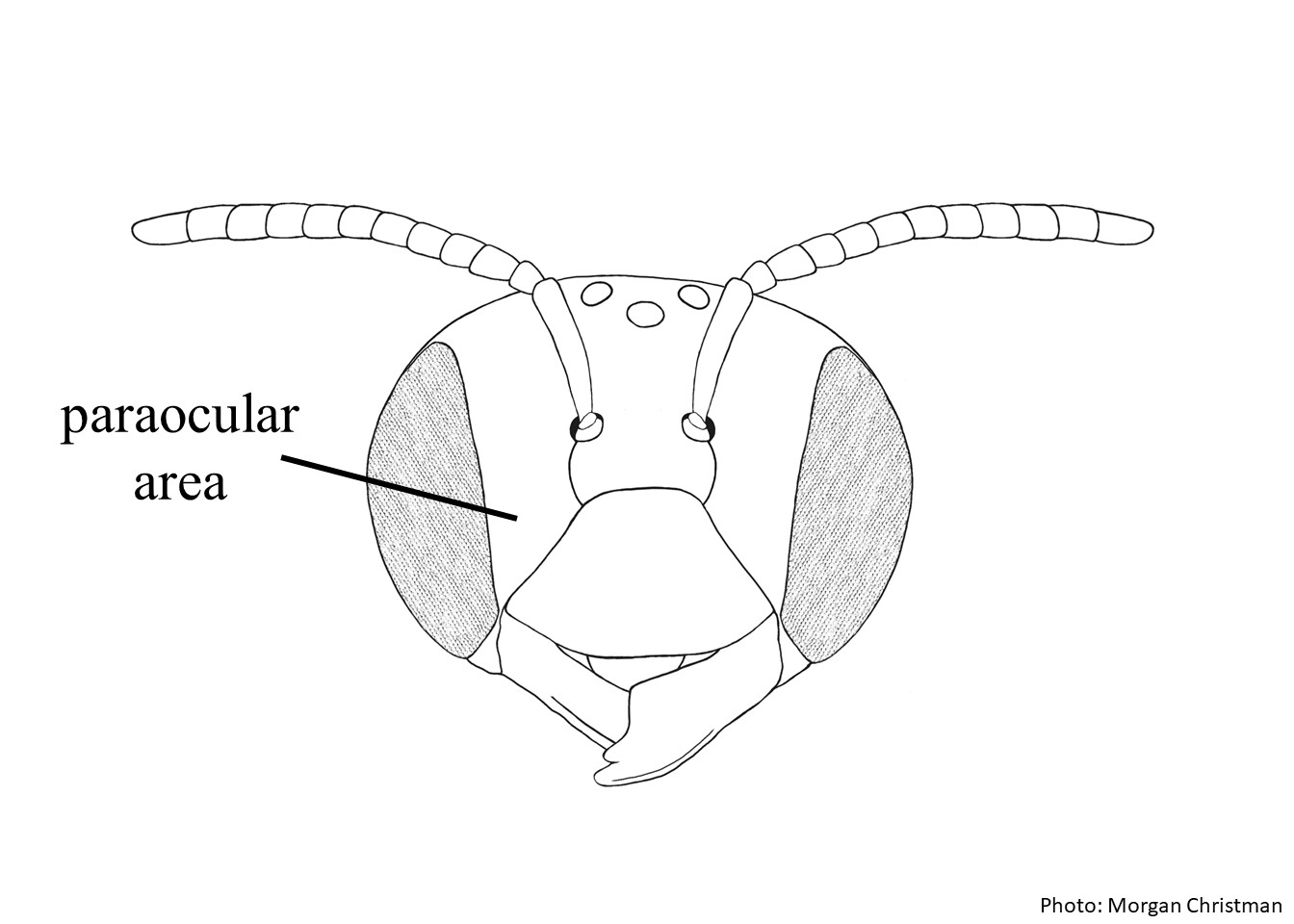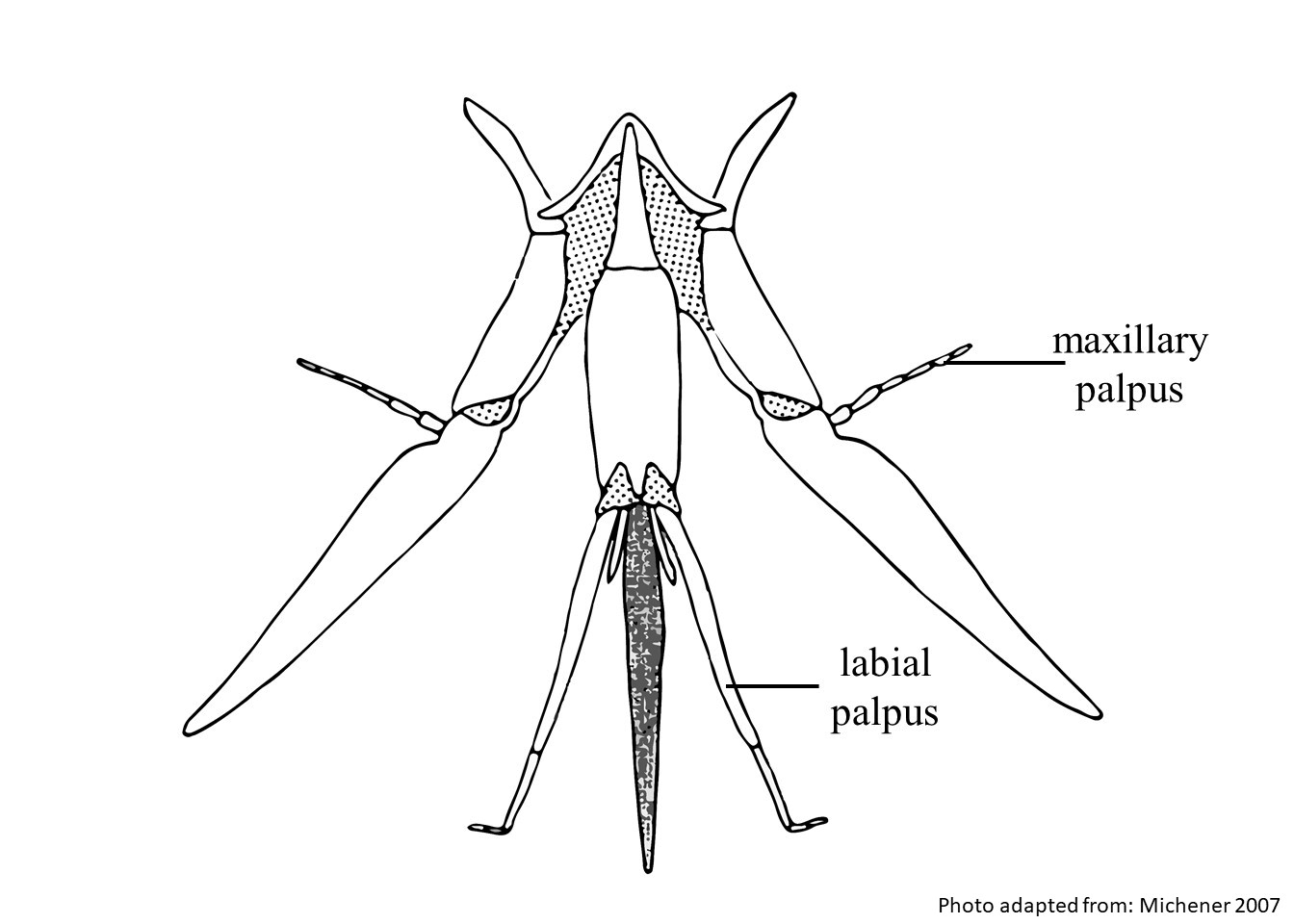Family: Apidae
Subfamily: Xylocopinae
Tribe: Ceratinini
Genus: Ceratina Latreille, 1802
Subgenus: Ceratinidia Cockerell and Porter, 1899
Common name: small carpenter bees
Ceratinidia is the most common subgenus of Ceratina in Asia (Hirashima 1971). They are black bees with abundant yellow markings on their head, thorax, and abdomen. Their body length varies from 5.0–11.5 mm (Michener 2007Michener 2007:
Michener, C.D. 2007. The Bees of the World (2nd ed.). Johns Hopkins University Press, Baltimore and London, 953 pp.).
(modified from Hirashima 1971aHirashima 1971a:
Hirashima, Y. 1971. Subgeneric classification of the genus Ceratina Latreille of Asia and West Pacific, with comments on the remaining subgenera of the world (Hymenoptera, Apoidea). Journal of the Faculty of Agriculture Kyushu University 16 (4): 349ndash;375.)
 above the antennae distinctly punctatepunctate:
above the antennae distinctly punctatepunctate: 6-segmented.
6-segmented. can be weak.
can be weak. and S3S3:
and S3S3: with wax glands present.
with wax glands present.Ceratina (Ceratinidia) may be confused with some species in C. (Xanthoceratina), C. (Lioceratina), and C. (Catoceratina), because of their similar yellow markings on all body segments. However, they can be separated from these other subgenera by the dense, coarse punctures on the fronsfrons:
the area between the antennae and ocelli on the bee's head, vertexvertex:
the area between the ocelli and the back of the head, and paraocular areaparaocular area:
the area extending along the sides of the face parallel to the eye
 above the antennae.
above the antennae.
Ceratina (Ceratinidia) are common of pollinators of various wild plants in far eastern Asia. They have been observed visiting the flowers of a number of plant families including Asteraceae, Caprifoliaceae, Ericaceae, Fabaceae, Rosaceae, Solanaceae (Lee et al. 2005Lee et al. 2005:
Lee, S., H. Kim, and W. Lee 2005. A review of the small carpenter bees, Ceratina , from Korea, with description of a new species (Hymenoptera: Apidae). Entomological News 116(3): 137ndash;146.).
Adult females of many species of Ceratina (Ceratinidia) use holes in the narrow stems or twigs of dead plants as nests for brood rearing including Asteraceae (Artemisia) and Poaceae (Miscanthus and Phragmatis) (Lee et al. 2005Lee et al. 2005:
Lee, S., H. Kim, and W. Lee 2005. A review of the small carpenter bees, Ceratina , from Korea, with description of a new species (Hymenoptera: Apidae). Entomological News 116(3): 137ndash;146.).
Ceratina (Ceratinidia) is the most diverse subgenus of Ceratina in Asia and contains a total of 50 species (Hirashima 1971aHirashima 1971a:
Hirashima, Y. 1971. Subgeneric classification of the genus Ceratina Latreille of Asia and West Pacific, with comments on the remaining subgenera of the world (Hymenoptera, Apoidea). Journal of the Faculty of Agriculture Kyushu University 16 (4): 349ndash;375.; Warrit et al. 2012Warrit et al. 2012:
Warrit, N., C.D Michener, and C. Lekprayoon. 2012. A review of the small carpenter bees of the genus Ceratina , subgenus Ceratinidia , of Thailand (Hymenoptera, Apidae). Proceedings of the Entomological Society of Washington 114(3): 398ndash;416.; Gupta et al. 2013Gupta et al. 2013:
Gupta, R.K., V.K. Mattu, and A. Kumar. 2013. A new species of the genus Ceratina Latreille, subgenus Ceratinidia Cockerell amp; Porter (Hymenoptera: Apidae), from Himachal Pradesh, India. Journal of Environmental Biological Sciences 27(1): 75ndash;77.; Ascher and Pickering 2020Ascher and Pickering 2020:
Ascher, J.S. and J. Pickering. 2020. Discover Life bee species guide and world checklist (Hymenoptera: Apoidea: Anthophila). https://www.discoverlife.org/mp/20p?see=Carinulaamp;name=Megachileamp;flags=subgenus :). The subgenus has been divided into three species groups, i.e., the compacta, bryanti, and flavipes (Yasumatsu and Hirashima 1969Hirashima 1969:
Hirashima, Y. 1969. Synopsis of the genus Pithitis Klug of the world (Hymenoptera: Anthophoridae). Pacific Insects 11: 649ndash;669.; Shiokawa and Hirashima 1982Shiokawa and Hirashima 1982:
Shiokawa, M. and Y. Hirashima. 1982. Synopsis of the flavipes -group of the genus Ceratina of Eastern Asia (Hymenoptera, Anthophoridae). Esakia 19: 177ndash;184.).
There are no known invasives.
Ceratina (Ceratinidia) is found from Sri Lanka and India, north through China to the maritime province of Siberia, east to Japan, and throughout southeastern Asia, including Taiwan, the Philippines, and Indonesia east to the western tip of New Guinea (Michener 2007Michener 2007:
Michener, C.D. 2007. The Bees of the World (2nd ed.). Johns Hopkins University Press, Baltimore and London, 953 pp.).

Distribution map generated by Discover Life -- click on map for details, credits, and terms of use.
Ascher J.S. and J. Pickering. August 2019. Discover Life bee species guide and world checklist (Hymenoptera: Apoidea: Anthophila). https://www.discoverlife.org/mp/20p?see=Ceratinidia&name=Ceratina&flags=subgenus:
Gupta, R.K., V.K. Mattu, and A. Kumar. 2013. A new species of the genus Ceratina Latreille, subgenus Ceratinidia Cockerell & Porter (Hymenoptera: Apidae), from Himachal Pradesh, India. Journal of Environmental Biological Sciences 27(1): 75–77.
Hirashima, Y. 1971. Subgeneric classification of the genus Ceratina Latreille of Asia and West Pacific, with comments on the remaining subgenera of the world (Hymenoptera, Apoidea). Journal of the Faculty of Agriculture Kyushu University 16(4): 349–375.
Lee, S., H. Kim, and W. Lee 2005. A review of the small carpenter bees, Ceratina, from Korea, with description of a new species (Hymenoptera: Apidae). Entomological News 116(3): 137–146.
Michener, C.D. 2007. The Bees of the World (2nd ed.). Johns Hopkins University Press, Baltimore and London, 953 pp.
Shiokawa, M. and Y. Hirashima. 1982. Synopsis of the flavipes-group of the genus Ceratina of Eastern Asia (Hymenoptera, Anthophoridae). Esakia 19: 177–184.
Warrit, N., C.D Michener, and C. Lekprayoon. 2012. A review of the small carpenter bees of the genus Ceratina, subgenus Ceratinidia, of Thailand (Hymenoptera, Apidae). Proceedings of the Entomological Society of Washington 114(3): 398–416.
Yasumatsu, K. and Y. Hirashima. 1969. Synopsis of the small carpenter bee genus Ceratina of Japan (Hymenoptera, Anthophoridae). Kontyu 37: 61–70.